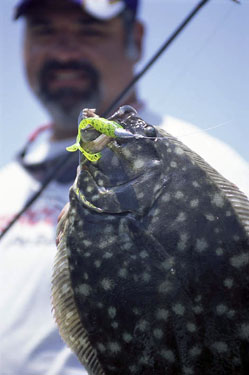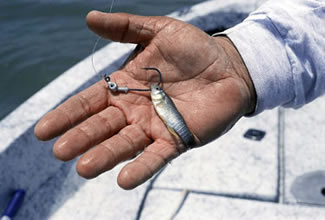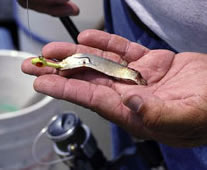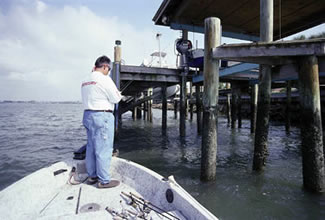May 16, 2011
By Chris Christian
Top-ranked bass pro chases flounder and finds them more of a challenge.
By Chris Christian

Flounder are the main target, but an occasional redfish may come to the boat. |
Pete Thliveros doesn't get overly excited about a fish. In fact, I once watched him sight-fish an 11-pound bass from a bed in Rodman Pool, and even after the fish was on, he was as calm and methodical as a surgeon in an operating room.
That's a pretty good trait for a full-time professional bass angler, which is what the 44-year-old Jacksonville native, called Peter T (as he is universally known) has been since 1987. It may also explain why he has been quite successful at it; winning several major championships, earning ten BASSMASTER Classic berths, while becoming one of only 25 anglers to achieve more than $1 million in tournament winnings.
Calm is good. But at the moment, Peter T wasn't quite as composed as usual, because this one particular flounder had been eating his lunch, so to speak.
“If bass were this tough I'd be broke,” he muttered, as he inspected his fourth mangled mud minnow.
Peter T is not easily deterred, so flipping a fresh minnow back under the dock, he eased it to the spot where the finicky flounder had been seriously depleting our supply of baitfish.
“There he is again,” he said, as he dropped his rodtip slightly. “He's just sitting there mouthing it. Come on...eat it...move with it!”
Watching Peter T get excited and frustrated about a fish is kinda fun. During the almost 20 years I've known him, it hasn't happened often. But when he finally stuck that 2-pound flounder and put it in the boat, his grin was probably bigger than when he landed that 11-pound bass.
Peter T has a thing about flounder. He pursues them with a passion.
“Don't Be Surprised |
The methodical, close-range, “bass-style” technique that Thliveros uses to fish docks is deadly on flounder. But, that is not the only fish you will catch.
Docks tend to draw a variety of fish.
Veteran trout anglers know that they are particularly attractive to “gator” trout. Redfish also like to snuggle up under docks. Either will chow down quickly on a finger mullet, mud minnow or plastic jig that happens to cross their nose.
You will also find school-size trout, jacks, ladyfish, black seabass and even the occasional black drum making periodic visits.
Advertisement
On one recent trip, a 12-pound bluefish even showed up and ate Peter T's bait. That's just one reason why he likes 20- to 30- (and sometimes even 40-) pound braid when pitching at docks.
With this particular technique, anglers will certainly catch flounder. But, don't be surprised if other fish fall for the same tricks.
|
|
“I have been fascinated by flounder ever since I was a little kid growing up in Jacksonville,” he says. “When I was a youngster I was fishing salt water from piers, beaches, any shoreline I could reach, and occasionally from a boat. I didn't get into bass fishing until I was a teenager. One of the things that really captured my attention was when my mom would take me to the pier for the day, and I got to watch guys fish for flounder.”
“They were using floats,” he says, “and you could watch the float go down, then come back up, then go down again, and then come back up. Flounder are not easy to catch on live bait, but these guys knew when to set the hook. They could ‘feel' when it was time, and that made flounder a special fish for me. Even as a 10-year-old kid, that was a challenge I wanted to master. I've been pursuing them ever since.”
So much so, that he set up a second boat just for inshore saltwater fishing. And, when he is not on the pro bass tour fishing for Team Crown Royal, you'll find him prowling First Coast waters. During summer months, that normally means he is specifically targeting flounder, because that is when they are most abundant from Fernandina to Matanzas Inlet.
June signals the start of prime flounder fishing along the First Coast, and it will continue until the first cold snaps of the fall. In some areas the start of the “run” is totally predictable. I can count on flounder invading the St. Augustine Inlet basin, and stacking up in Salt Run, just by looking at the calendar. The same holds true at Mayport, and from those areas the flounder tend to spread throughout the Intracoastal Waterway and St. Johns River for the summer. And spread out they do.
During 15 years spent as a bass guide in the Lake George area, I could count on catching flounder in Little Lake George (near Welaka) during June and July. As the crow flies, that's over 70 miles up the St. Johns River from the Mayport jetties (even more as flounders swim). I have no idea whether those fish live there year-round and only bite during the summer, or whether they make a mad dash from Mayport to get there in time to eat my lures. But, they were consistent enough that I caught them regularly on plastic worms and jigs while guiding for bass—and there are a couple of bars and drops where I could actually target them with a fair chance of success.
More than a few other bass fishermen in the St. Johns River have nabbed a flounder or two while bouncing a plastic worm for bass. In fact, when it comes to cashing in on the summer flounder run, Peter T may climb into his saltwater boat, but he is basically going “bass fishing.”
“There aren't a lot of people who specifically fish for flounder,” he says. “I suspect that most flounder are caught by accident while fishing for other species...or just fishing for whatever will bite. But, those anglers who target them with success are actually very similar to largemouth bass fishermen in their approach. There are a lot of similarities between the two fish, and an angler who has some experience with largemouth bass in a tidal environment isn't going to have a lot of trouble catching flounder. They can actually use the same equipment and tactics.”
Start by pitching the bait under the dock, easing it back along bottom. |
|
The bigg
est similarity between largemouths and flounder is that they are both very structure oriented. They love to snuggle up next to something. In the case of bass, it may be the edge of a weedline, a log, brushpile, a submerged point or a sharp drop or ledge.
Flounder are equally edge-oriented and notorious for sliding right up to the edge of an oyster bar, concrete bulkhead, a rock jetty or the edge of a spartina grassline. One area often overlooked is anywhere a concrete bulkhead forms a corner. Peter T notes that this can be a flounder magnet often bypassed by anglers.
Points are another favored haunt. On a falling tide, any small point located near a creekmouth can be a gold mine. On a rising tide a point connecting a flat with a deeper channel can see a significant movement of flounder, particularly the larger fish. For a bass fisherman, that's pretty basic stuff.
So, too, are docks. Bass love those, and so do flounder. In fact, of all potential flounder-holding cover items, Thliveros rates docks as the most consistent producer.

Lip-hooked mud minnow is a super bait. |
“Flounder are even more dock-oriented than bass,” he notes. “They'll hang on the outside edges, move up underneath them, and even follow the walkway up to the shoreline with the tide. It's pretty much an ideal situation for them, because they have both vertical and horizontal cover to hang on, and flounder love cover.”
As any serious bass fisherman has discovered, bass love docks, too, but not all docks appeal to them. There are certain combinations of depth and dock construction that draw fish on a consistent basis, and anglers can pretty much count on a strike from them while nearby docks might be barren. The same holds true for flounder. Thliveros notes that his most productive docks are relatively shallow (three to five feet of water below) and have a shallow flat leading up to them, as opposed to deeper docks that sit on a sharp channel break. Docks on a shallow point are generally a better bet than those on a deeper outside channel bend, and any shallow dock downcurrent from a tidal creekmouth can be hot on the lower end of the ebb tide. Also make a few casts on the upcurrent side of a creekmouth, as this is where larger fish often ambush bait.
Peter T works a dock for flounder in the same methodical manner he does for bass. Easing the bow of the boat up to the downcurrent side with his trolling motor, he'll start by pitching or skipping the bait back underneath and easing it back along the bottom to him. Flounder will sometimes lie behind a piling, and sometimes in the gaps between them. He wants to make certain he systematically covers every inch he can reach. When one piling gap is covered, he moves the boat to the next. After the downcurrent side is worked he will move to the outside face and fan-cast the outside edge, before moving in to work the piling's gaps.

And so is a strip of mullet. |
As far as tackle goes, his bass gear works fine. A 6 1/2-foot, medium-action rod gets the nod for spinning or casting, and either will be spooled with 20- to 30-pound braided line. Like a growing number of anglers, he's convinced that braid not only provides more sensitivity (important with a fish that can bite as softly as a flounder), but is more abrasion-resistant than monofilament—a big plus when trying to wrestle a fish from a cluster of barnacle-laden pilings.

Trolling motor allows you to hold in position to work a dock. |
One big difference from bass fishing is in what adorns the rig. Although a 3- or 4-inch soft-plastic jig, or even a plastic worm, will catch a lot of flounder, Peter T is convinced that live bait will catch more and bigger fish.
“If I could pick the ideal bait, it would be a 3- to 4-inch finger mullet or the same size pogy,” he says. “Usually, I can castnet a good supply pretty quickly. If I can't find smaller mullet or pogies, a strip bait can be cut from larger baits and will work fairly well, but that would be a last resort kind of thing. If I know that smaller mullet and pogies aren't around, I'll stop at a bait shop on the way to the ramp and get some mud minnows. A jig is an effective bait for covering a lot of water to find fish, but when it comes to working a dock, I believe a live bait will get you more strikes.”
Rigging is simple. For shallower docks the bait is slipped onto a bare jighead in the 1/8- to 1/4-ounce range. In deeper water, or fast current, he'll make up a Carolina rig with a 1/2- to 1-ounce sinker, a short (6- to 8-inch) leader, and a 1/0 Kahle-style hook.
Either rig will generate a lot of hits. But, as Peter T discovered many years ago, it's what you do after the hit that determines success. When a flounder strikes a lure you can merely react. When one grabs a live bait, you have to think.
“The thing that makes flounder so challenging to me,” Thliveros says, “is that there is no such thing as a standard strike. They can be really aggressive or very picky, especially with live bait. What I have to do is read the strike and then figure out the fish.”
“When I first feel a hit,” he continues, “I let the fish tell me when to set the hook. If that flounder nails the bait and swims off steadily, I can set the hook immediately because that's an aggressive fish and it already has the bait down. If the hit is a soft bump and the bait just stops, I'll push the button on my reel (or open the bail on a spinner) and let the fish have the bait. After that I'll hold the line and put a very light pressure on the fish. Sometimes that will make them swim, but sometimes they may only move a few feet and they'll stop again. I'll keep playing that ‘touchy feely' game with the fish until it moves off steadily, and then I'll set the hook.”
“I don't always get it right,” he laughs, “but that's what keeps me coming back. I'm just glad that bass aren't this tough.”
FS
Advertisement
